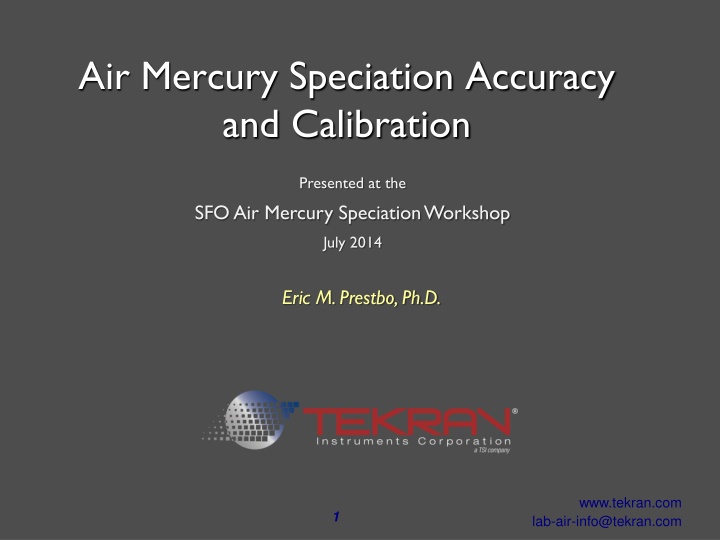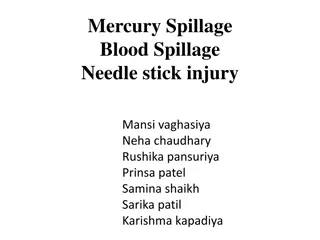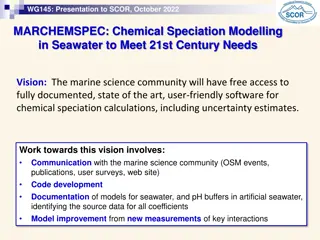Advances in Automated Mercury Speciation Measurement Methods
This content delves into the world of automated mercury speciation measurement methods, focusing on accuracy, calibration, and historical perspectives. It discusses challenges in measuring GEM, PBM2.5, and GOM with hourly resolution, highlighting the significance of continuous monitoring in various atmospheric conditions. The advancements in automated Hg speciation methods and the importance of precise measurements for scientific coherence are emphasized.
Download Presentation

Please find below an Image/Link to download the presentation.
The content on the website is provided AS IS for your information and personal use only. It may not be sold, licensed, or shared on other websites without obtaining consent from the author.If you encounter any issues during the download, it is possible that the publisher has removed the file from their server.
You are allowed to download the files provided on this website for personal or commercial use, subject to the condition that they are used lawfully. All files are the property of their respective owners.
The content on the website is provided AS IS for your information and personal use only. It may not be sold, licensed, or shared on other websites without obtaining consent from the author.
E N D
Presentation Transcript
Air Mercury Speciation Accuracy and Calibration Presented at the SFO Air Mercury Speciation Workshop July 2014 Eric M. Prestbo, Ph.D. www.tekran.com lab-air-info@tekran.com 1
GOM & PBM ~ 1 ppqv How hard can it be to measure Hg speciation? Cl GEM ~ 170 ppqv How likely is it that an automated atmospheric speciation system can automatically measure at the 1 PPQV (10 pg/m3) level without any artifact bias in all types of atmospheres such as Arctic, urban Asia, free-trop, tropics, sub-tropics, marine, desert, etc.? HgCl2 Particle HgCl2 Hg0 Hg0 Hg0 O O O Calvert and Lingberg (2005) www.tekran.com lab-air-info@tekran.com 2
Q1: Is there a better way? Starting over, is there a better way to continuously measure GEM, PBM2.5 and GOM with hourly resolution, 5 pg/m3 (0.5 ppqv) DL and routine GEM and periodic GOM calibration? Conclusion A 2.5 um inlet > annular denuder > particulate filter > gold-trap AFS is the only method that makes sense for the vast majority of ongoing and future scientific programs www.tekran.com lab-air-info@tekran.com 3
Automated Hg Speciation Method (pat d) PBM Method is: GEM Lab tested Widely published QA Challenged Adopted by all advanced int l & national networks GOM www.tekran.com lab-air-info@tekran.com 4
SIDEBAR www.tekran.com lab-air-info@tekran.com 5
Historical Perspective for Atm. Hg Speciation Measurement 1994 GENESIS: Small group of international experts convened and concluded that GOM should exist & method development must be a high priority (EPRI Report). EARLY EXAMPLE: 1996 at ICMGP Report of unbelievable GOM levels of ~800 pg/m3 at Izania free troposphere site using manual filter pack method (Prestbo and Bloom). Is method biased? DISCOVERY: 2000 - Using automated Hg speciation method, Landis and many others* started reporting high GOM in the free troposphere and Swartzendruber et al. (2006) published the first peer-reviewed article. *Lyman, Jaffe, Obrist, Sheu, Feng, Slemr . www.tekran.com lab-air-info@tekran.com 6
Select Hg Speciation Discoveries High GOM and PBM observations where reactive halogen chemistry is favorable Polar Regions, Dead Sea, Free Troposphere, Marine Boundary Layer Elevated PBM/GOM from Biomass fires Confirmation of speciated mercury emissions from point sources Coal Burning, Chlor-Alkali Plants & Waste Incinerators Conclusion: Hg speciation measurements are scientifically coherent www.tekran.com lab-air-info@tekran.com 7
Two questions for the automated air mercury speciation method Scientists are asking: Exactly what is being measured? How accurate are the GOM and PBM measurements? www.tekran.com lab-air-info@tekran.com 8
QA Challenge Example: GOM Manifold Comparison of 3 Tekran Systems (See Olson et al., ICMGP-2013) www.tekran.com lab-air-info@tekran.com 9
Side-Bar: Accuracy dependent on siting, operation, maintenance and QA 2007 Survey Says experts rarely do external calibration and no audit of the sample volume measurement Inlet must be in free air with unobstructed large fetch Current and developing networks are improving the accuracy of Hg speciation measurements CAMNet/CAPMoN, UBA-Germany, AMNet, GMOS, EMEP, AMAP, S. Korea, etc. www.tekran.com lab-air-info@tekran.com 10
Traceable Hg0 calibration and performance check options Automated calibration with permeation source Validation of permeation source at injection port Manual standard additions at injection port Automated perm source std. additions with 1120 Model 2537 Schematic Model 1120 Controller Hg0 perm source www.tekran.com lab-air-info@tekran.com 11
Traceable Hg0 fictive-loss test options during ambient air sampling Simple manual Hg0 injection upstream of the soda lime 1. Difficult manual Hg0 injection at 1130 inlet 2. 1 Automated proposed permeation source Hg injection at 1130 inlet 3. 2 3 www.tekran.com lab-air-info@tekran.com 12
GOM Calibration Challenges HgCl2 and HgBr2 are solids at room temperature, so will adsorb to reactive and/or unheated surfaces Thus, quantitative transport requires optimization for laminar flow and short residence time (Tekran 1130 inlet and denuder)and/or brute force of high temperature through entire, non-reactive flow path (150-180 C) www.tekran.com lab-air-info@tekran.com 13
GOM Calibration Challenges HgCl2 adsorbed to surfaces will convert to Hg0, especially at high temperature or even changing air chemistry parts per quadrillion(10 to 500 picogram/m3) concentrations required for calibration Source must be stable, reproducible, robust and can be turned on & off www.tekran.com lab-air-info@tekran.com 14
Traceable Calibration of GOM Measurements Available Methods 1. Reaction of traceable Hg0 + 2 Cl > HgCl2(g) (catalyzed by reactive metal surface) 2. Gas permeation of pure solid HgBr2 to HgBr2 gas (sublimation) 3. Nebulization of NIST traceable standard [HgCl4]2- solution 4. Manifold Spiking Research Ideally use independent NIST traceable GOM Source Not 100% efficient www.tekran.com lab-air-info@tekran.com 15
The Trouble with Permeation for GOM Calibration ADSORPTION:Loss to surfaces in perm chamber or transport tubing (when off, cold spots) means device emission rate is a function of permeation and wall emissions. STABILITY:Wall losses in chamber or transport tubing, means that it can take weeks to stabilize or worse, the rate changes between uses TEMPERATURE: small changes in chamber or transport line temperature and/or humidity can cause big side-effects CONVERSION: HgBr2 and HgCl2 will convert to Hg0 on surfaces www.tekran.com lab-air-info@tekran.com 16
Nebulizing Liquid Hg Standard Tekran Model 3315 Proven, traceable GOM source for HgCEM equipment QA Designed for 30 lpm and 1-40 ug/m3 Challenge is to modify device for delivery of GOM to the Tekran Model 1130 inlet at 1-15 lpm and 20 - 1000 pg/m3. www.tekran.com lab-air-info@tekran.com 17
Manifold Studies RAMIX Comments Gustin et al., doi:10.1021/es3039104 Manifold studies to assess GOM and PBM accuracy are challenging and have a high degree of risk. Ideal manifold design prototype The ideal manifold study would use GOM and GEM generators that are NIST traceable and independent of the measuring equipment being evaluated. RAMIX used a GOM permeation source, calibrated by the same equipment being evaluated. www.tekran.com lab-air-info@tekran.com 18
Manifold Studies RAMIX Comments Gustin et al., doi:10.1021/es3039104 GEM measurements did not agree using 2 highly QA d identical Hg speciation instruments (Tekran) connected to the RAMIX manifold. A 30% fudge factor was applied to correct this experimental bias. GEM comparisons with two fully QA d Hg speciation instruments are nominally better than 5%. GOM is nominally 10%. www.tekran.com lab-air-info@tekran.com 19
Manifold Studies RAMIX Comments Gustin et al., doi:10.1021/es3039104 Non-standard setup. 1.5 meters of inlet line & 4 lpm flow rate for the Tekran Hg speciation equipment. Transport losses and species conversion likely, but not tested. Lab manifold tests were done on a length of the field manifold. Lab tests showed uncertainty and less than 100% transmission efficiency for GEM & GOM. Flow uncertainty was +/- 15% Unusual results were explained by hypothesizing that GOM was generated in the manifold. www.tekran.com lab-air-info@tekran.com 20
Conclusions Determination of accuracy for GOM and PBM at the parts per quadrillion level are difficult, but badly needed The Tekran 3315 modified for ambient levels may be the best option for field-based GOM accuracy determination. Tekran needs willing partners and funding to implement. Manifold studies for accuracy are difficult to do and prone to have their own artifacts www.tekran.com lab-air-info@tekran.com 21
Q2: What does the consensus of the research & monitoring community need to improve accurate Hg speciation measurements, at high resolution, with a commercially available and supported system? Current 2537-1130/1135 system, with modifications to improve accuracy & robustness and add a GOM calibration source? 1. A system that switches a 2537 between a GEM and TAM2.5 mode, with the difference being a function of [GOM+PBM2.5 + VGEM-PBM-GOM], where VGEM-PBM-GOM is the natural variability of these species over the 5 to 10 minute time cycle of measurement. Est. DL of 100 pg/m3 and 30% uncertainty? 2. A UW - DOHGS type system with two Tekran 2537 Units measuring TAM1.0 and GEM simultaneously, including a GOM calibration source. Est DL of 50 pg/m3? 3. Other? 4. www.tekran.com lab-air-info@tekran.com 22
Tekran future contributions to improve GOM/PBM automated method Prestbo would be willing to ask Tekran to contribute a large amount of in-kind resources to an acceptable, funded research project to develop modifications and new calibration sources for the 2537-1130-1135 system. Open invitation .. The size of the problem seems to require a coordinated, funded contribution from a larger community of atmospheric Hg experts www.tekran.com lab-air-info@tekran.com 23


![[PDF⚡READ❤ONLINE] Planet Mercury: From Pale Pink Dot to Dynamic World (Springer](/thumb/21549/pdf-read-online-planet-mercury-from-pale-pink-dot-to-dynamic-world-springer.jpg)




















